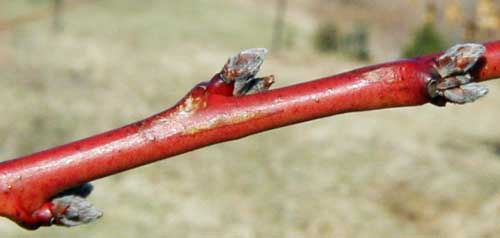Winter dormancy and chilling in woody plants
A warm winter means woody plants will be ready to grow when the weather warms up.
Since most plants do not grow during the winter, we say they are dormant. There are actually two types of dormancy during the winter. One is called endo-dormancy. In endo-dormancy, the plant will not grow even under good, warm, growing conditions. Endo is a Greek word meaning inside. In endo-dormancy, something inside the plants is inhibiting growth. The other is called eco-dormancy and occurs when the plant is ready to grow but the environmental conditions are not right, usually too cold. Endo-dormancy occurs first. Short days and freezing temperatures in the fall induce endo-dormancy in the plant. (See the Michigan State University Extension article, “Fall color show and winter dormancy in woody plants.”)
As the plant enters endo-dormancy, it tracks chilling units to track the passage of the winter. Chilling units are hours of time spent above freezing. The number of hours required for chilling varies for different plants from less than 500 to 1,500 hours or more. Many people think the plant is tracking hours below freezing. It is not. Hours below freezing have no effect on chilling, but will increase cold hardiness. If warm weather occurs before the plant completes its chilling requirement, no growth occurs. Chilling and endo-dormancy normally prevent plants from beginning growth during warm spells in the middle of the winter. Not all hours above freezing are equal. Temperatures between 40 and 50 degrees Fahrenheit (5 to 10 degrees Celsius) are most effective. Temperatures just above freezing and above 50 F are less effective and temperatures above 60 F often have a negative effect on chilling.

These peach buds appear dormant, but have completed their chillingrequirement and are waiting for warmer weather to begin growth. Photo credit: Mark Longstroth, MSUE
Plants from the south or far north have relatively short chilling requirements. In the far north, it is below freezing for a long time and the spring warm-up is relatively short. Likewise winters in the south are short and mild. Plants from the middle temperate regions like Michigan have relatively long chilling requirements that keep them dormant through the long stretches when the temperatures cycle above and below freezing in a Michigan winter. Most of the fruit crops we grow in Michigan have chilling requirements of 700 to 1,300 chilling units. We normally complete endo-dormancy here in Michigan in January, early January in the south and late January in the north. Of course, there are big differences between winters. Some are long and cold, others are warmer. The relatively warm winter we are experiencing in 2013 is allowing many plants to accumulate their chilling earlier than normal.
Another important thing happens during endo-dormancy. The plants are cold hardy. As long as the trees, bushes or vines are in endo-dormancy, they have the ability to acclimate to cold weather; we call this cold hardiness. As long as the temperatures are below freezing, the plants are ready for really cold temperatures. Maximum cold hardiness occurs when plants have been subject to cold, subfreezing temperatures for several days or more. As long as the plants are in endo-dormancy they have the ability to acclimate to colder temperatures and withstand winter cold.
After chilling is completed the plants are no longer in endo-dormancy. They are now in eco-dormancy. The plants are dormant only because of cold or cool weather. Warmer temperatures into the mid-40s will cause them to begin growth. Once the plants start to grow, they lose the ability to readjust to colder temperatures. There is usually a slow progression of development when the plant begins to grow as the temperatures slowly rise. Growth first becomes apparent when buds swell and then green tissue emerges from the bud. The plants actually begin growing before we notice the buds swelling.



 Print
Print Email
Email




